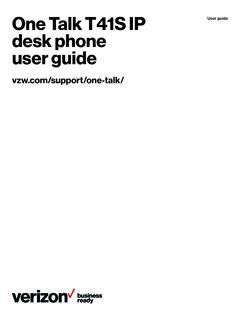Transcription of Assigning the Switch IP Address and Default Gateway - Cisco
1 CHAPTER 3-1 Catalyst 2960 Switch Software Configuration GuideOL-8603-043 Assigning the Switch IP Address and Default GatewayThis chapter describes how to create the initial Switch configuration (for example, Assigning the IP Address and Default Gateway information) for the Catalyst 2960 Switch by using a variety of automatic and manual methods. It also describes how to modify the Switch startup configuration. NoteFor complete syntax and usage information for the commands used in this chapter, see the command reference for this release and the Cisco IOS IP Command Reference, Volume 1 of 3: Addressing and Services from the page under Documentation > Cisco IOS Software > Mainline > Command chapter consists of these sections: Understanding the Boot Process, page 3-1 Assigning Switch Information, page 3-2 Checking and Saving the Running Configuration, page 3-10 Modifying the Startup Configuration, page 3-11 Scheduling a Reload of the Software Image, page 3-16 Understanding the Boot ProcessTo start your Switch , you need to follow the procedures in the Getting Started Guide or the hardware installation guide for installing and powering on the Switch and setting up the initial Switch configuration (IP Address , subnet mask, Default Gateway , secret and Telnet passwords, and so forth).
2 The normal boot process involves the operation of the boot loader software, which performs these activities: Performs low-level CPU initialization . It initializes the CPU registers, which control where physical memory is mapped, its quantity, its speed, and so forth. Performs power-on self-test (POST) for the CPU subsystem. It tests the CPU DRAM and the portion of the flash device that makes up the flash file system. Initializes the flash file system on the system board. Loads a Default operating system software image into memory and boots up the Switch . 3-2 Catalyst 2960 Switch Software Configuration GuideOL-8603-04 Chapter 3 Assigning the Switch IP Address and Default GatewayAssigning Switch InformationThe boot loader provides access to the flash file system before the operating system is loaded. Normally, the boot loader is used only to load, uncompress, and launch the operating system. After the boot loader gives the operating system control of the CPU, the boot loader is not active until the next system reset or boot loader also provides trap-door access into the system if the operating system has problems serious enough that it cannot be used.
3 The trap-door mechanism provides enough access to the system so that if it is necessary, you can format the flash file system, reinstall the operating system software image by using the Xmodem Protocol, recover from a lost or forgotten password, and finally restart the operating system. For more information, see the Recovering from a Software Failure section on page 32-2 and the Recovering from a Lost or Forgotten Password section on page can disable password recovery. For more information, see the Disabling Password Recovery section on page you can assign Switch information, make sure you have connected a PC or terminal to the console port, and configured the PC or terminal-emulation software baud rate and character format to match these of the Switch console port: Baud rate Default is 9600. Data bits Default is the data bits option is set to 8, set the parity option to none. Stop bits Default is 1. Parity settings Default is Switch InformationYou can assign IP information through the Switch setup program, through a DHCP server, or the Switch setup program if you want to be prompted for specific IP information.
4 With this program, you can also configure a hostname and an enable secret password. It gives you the option of Assigning a Telnet password (to provide security during remote management) and configuring your Switch as a command or member Switch of a cluster or as a standalone Switch . For more information about the setup program, see the hardware installation a DHCP server for centralized control and automatic assignment of IP information after the server is configured. NoteIf you are using DHCP, do not respond to any of the questions in the setup program until the Switch receives the dynamically assigned IP Address and reads the configuration you are an experienced user familiar with the Switch configuration steps, manually configure the Switch . Otherwise, use the setup program described previously. 3-3 Catalyst 2960 Switch Software Configuration GuideOL-8603-04 Chapter 3 Assigning the Switch IP Address and Default GatewayAssigning Switch InformationThese sections contain this configuration information: Default Switch Information, page 3-3 Understanding DHCP-Based Autoconfiguration, page 3-3 Manually Assigning IP Information, page 3-10 Default Switch InformationTa b le 3 - 1 shows the Default Switch DHCP-Based AutoconfigurationDHCP provides configuration information to Internet hosts and internetworking devices .
5 This protocol consists of two components: one for delivering configuration parameters from a DHCP server to a device and a mechanism for allocating network addresses to devices . DHCP is built on a client-server model, in which designated DHCP servers allocate network addresses and deliver configuration parameters to dynamically configured devices . The Switch can act as both a DHCP client and a DHCP DHCP-based autoconfiguration, your Switch (DHCP client) is automatically configured at startup with IP Address information and a configuration DHCP-based autoconfiguration, no DHCP client-side configuration is needed on your Switch . However, you need to configure the DHCP server for various lease options associated with IP addresses. If you are using DHCP to relay the configuration file location on the network, you might also need to configure a Trivial File Transfer Protocol (TFTP) server and a Domain Name System (DNS) DHCP server for your Switch can be on the same LAN or on a different LAN than the Switch .
6 If the DHCP server is running on a different LAN, you should configure a DHCP relay device between your Switch and the DHCP server. A relay device forwards broadcast traffic between two directly connected LANs. A router does not forward broadcast packets, but it forwards packets based on the destination IP Address in the received autoconfiguration replaces the BOOTP client functionality on your 3-1 Default Switch InformationFeatureDefault SettingIP Address and subnet maskNo IP Address or subnet mask are gatewayNo Default Gateway is secret passwordNo password is factory-assigned Default hostname is passwordNo password is command Switch nameNo cluster name is defined. 3-4 Catalyst 2960 Switch Software Configuration GuideOL-8603-04 Chapter 3 Assigning the Switch IP Address and Default GatewayAssigning Switch InformationDHCP Client Request ProcessWhen you boot up your Switch , the DHCP client is invoked and requests configuration information from a DHCP server when the configuration file is not present on the Switch .
7 If the configuration file is present and the configuration includes the ip Address dhcp interface configuration command on specific routed interfaces, the DHCP client is invoked and requests the IP Address information for those 3-1 shows the sequence of messages that are exchanged between the DHCP client and the DHCP 3-1 DHCP Client and Server Message ExchangeThe client, Switch A, broadcasts a DHCPDISCOVER message to locate a DHCP server. The DHCP server offers configuration parameters (such as an IP Address , subnet mask, Gateway IP Address , DNS IP Address , a lease for the IP Address , and so forth) to the client in a DHCPOFFER unicast message. In a DHCPREQUEST broadcast message, the client returns a formal request for the offered configuration information to the DHCP server. The formal request is broadcast so that all other DHCP servers that received the DHCPDISCOVER broadcast message from the client can reclaim the IP addresses that they offered to the DHCP server confirms that the IP Address has been allocated to the client by returning a DHCPACK unicast message to the client.
8 With this message, the client and server are bound, and the client uses configuration information received from the server. The amount of information the Switch receives depends on how you configure the DHCP server. For more information, see the Configuring the TFTP Server section on page the configuration parameters sent to the client in the DHCPOFFER unicast message are invalid (a configuration error exists), the client returns a DHCPDECLINE broadcast message to the DHCP DHCP server sends the client a DHCPNAK denial broadcast message, which means that the offered configuration parameters have not been assigned, that an error has occurred during the negotiation of the parameters, or that the client has been slow in responding to the DHCPOFFER message (the DHCP server assigned the parameters to another client).A DHCP client might receive offers from multiple DHCP or BOOTP servers and can accept any of the offers; however, the client usually accepts the first offer it receives. The offer from the DHCP server is not a guarantee that the IP Address is allocated to the client; however, the server usually reserves the Address until the client has had a chance to formally request the Address .
9 If the Switch accepts replies from a BOOTP server and configures itself, the Switch broadcasts, instead of unicasts, TFTP requests to obtain the Switch configuration ADHCPACK (unicast)DHCPREQUEST (broadcast)DHCPOFFER (unicast)DHCPDISCOVER (broadcast)DHCP server51807 3-5 Catalyst 2960 Switch Software Configuration GuideOL-8603-04 Chapter 3 Assigning the Switch IP Address and Default GatewayAssigning Switch InformationConfiguring DHCP-Based AutoconfigurationThese sections contain this configuration information: DHCP Server Configuration Guidelines, page 3-5 Configuring the TFTP Server, page 3-6 Configuring the DNS, page 3-6 Configuring the Relay Device, page 3-6 Obtaining Configuration Files, page 3-7 Example Configuration, page 3-8If your DHCP server is a Cisco device, for additional information about configuring DHCP, see the Configuring DHCP section of the IP Addressing and Services section of the Cisco IOS IP Configuration Guide from the page under Documentation > Cisco IOS Software > Mainline > Configuration Guides.
10 DHCP Server Configuration GuidelinesFollow these guidelines if you are configuring a device as a DHCP server:You should configure the DHCP server with reserved leases that are bound to each Switch by the Switch hardware you want the Switch to receive IP Address information, you must configure the DHCP server with these lease options: IP Address of the client (required) Subnet mask of the client (required) DNS server IP Address (optional) Router IP Address ( Default Gateway Address to be used by the Switch ) (required)If you want the Switch to receive the configuration file from a TFTP server, you must configure the DHCP server with these lease options: TFTP server name (required) Boot filename (the name of the configuration file that the client needs) (recommended) Hostname (optional)Depending on the settings of the DHCP server, the Switch can receive IP Address information, the configuration file, or you do not configure the DHCP server with the lease options described previously, it replies to client requests with only those parameters that are configured.














